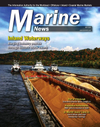
Page 22: of Marine News Magazine (May 2020)
Inland Waterways
Read this page in Pdf, Flash or Html5 edition of May 2020 Marine News Magazine
COLUMN INLAND WATERWAYS
By James Kearns, Special Counsel, Jones Walker LLP
With developments in the current two arguments. First, the industry will point out that it does, health crisis almost entirely consuming in fact, contribute to the cost of maintaining our nation’s wa- nearly all news reporting, one could be terways infrastructure through the tax that is imposed on the forgiven for thinking that the members of fuel that is used by towboats on the rivers and that is paid into
Congress are thinking about and working the Inland Waterways Trust Fund (IWTF), to support new and on little else, and that even if they were, replacement construction and major rehabilitation of the locks the divisive partisanship of recent years and dams throughout the river system. The industry will further would doom the prospects of much else call attention to the fact that several years ago that fuel tax was getting done. Happily, that is not the case increased by 45% at the river navigation industry’s own request.
Kearns for the nation’s inland waterways. Both The second major argument made by the navigation indus- houses of Congress are diligently working try is that, unlike the roads and highways on which people on maintaining the momentum of passing a Water Resources drive, the rivers provide many bene?ts in addition to transport- and Development Act (WRDA) every two years, trying not to ing cargo and passengers. The commercial users are the only break stride after passing such legislation in 2014, 2016, and bene?ciaries of the inland waterways system who pay a user 2018 with large bipartisan majorities. fee in the form of the fuel tax. Those bene?ciaries who receive
The work on a Water Resources and Development Act for ?ood control, water supply, recreational, and similar bene?ts 2020 has provided yet another occasion to consider a fundamen- do not pay a fuel tax or fee to contribute to the construction or tal and recurring question: Who are the true bene?ciaries of the maintenance of the system providing these bene?ts.
nation’s inland waterways? This question is re?ected in several of Each time that the process gets underway for creating the the things that WRDA 2020 is being asked to do, and to avoid. next WRDA, the river navigation industry goes on high alert
At the top of the river industry’s First-Do-No-Harm List is to make sure that some form of user toll is not included—or avoiding lockage fees or other forms of user fees that would be better yet, is expressly prohibited—in the legislation that is ?- the functional equivalent of toll booths at the locks and dams nally enacted. “We are not the only ones who bene?t from the throughout the river system. For the past several years, in both inland waterways system,” the industry says. “Let the other the current administration and the previous one, the President’s bene?ciaries pay their fair share.” budget has included a proposal for such fees in one form or an- But how can that “fair share” be quanti?ed in dollar terms? other. The concept has a super?cial appeal: why shouldn’t barge Extensive and detailed studies have been undertaken in an at- tows pay tolls to help cover the cost of maintaining the water- tempt to do that, a prominent example of which is “Toward a ways that they use just as trucks and cars pay tolls to help cover Full Accounting of the Bene?ciaries of Navigable Waterways,” the cost of maintaining the highways on which we all drive? prepared by Dr. Larry G. Bray, C. Michael Murphree, and
The river navigation industry has consistently—and thus far Chrisman A. Dager of the Center for Transportation Research successfully—resisted these repeated proposals primarily with at the University of Tennessee, available on the website of the © Paul D. Lemke / Adobe Stock
May 2020 22 MN

 21
21

 23
23
